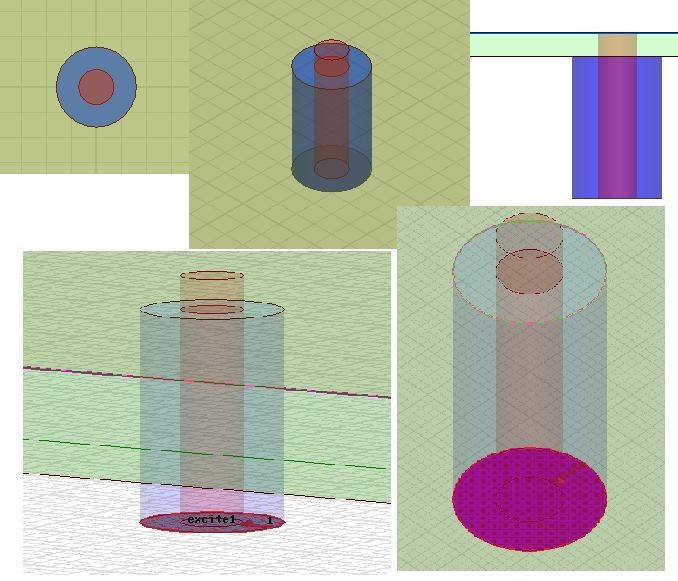Coaxial feed with lumped port and radiation setup problem
please pardon my wrong grammar if it went wrong somewhere, i tried:/
------
I tried to design a patch antenna with coaxial feeding by HFSS
the solution type is driven model
and the feeding type is going to be lumped port
------
I drew two cylinders and set material inside with copper and outside vacuum
also one cycle beneath to set as a excite port
the lumped port integration line is as Fig.
the problem is..
at first i didn't set any radiation boundary box for the simulation,
and the simulation worked without an error
then I found I can't get the patterns bcuz no radiation was set
then I draw the box set as radiation , sized lamda/4 larger starting from each
it came out the error:
----
Adaptive solution setup, process hf3d: '1' conductors touch lumped port '1', typically a lumped port contains 2 conductors. Please verify conducting boundaries and objects are correctly assigned and touch the port. If a Radiation boundary touches the port and it is desired for use during the port solution, select 'Use Radiation Boundary on Ports' under the Advanced tab in the Solution Setup
----
then the simulation went wrong anyhow
I tried to substitute as wave port but seems the radiation box was wrong set
its appreciated that someone can rectify my thoughts,
lots of thanks!
a simple diagram as below:

The problem is what the message says: your coax has inner conductor only (and dielectric), but the outer conductor is missing. The outer conductor would be connected to the ground plane underneath the patch.
Thanks, does it mean i should draw another PEC(or copper) cylinder outside the two cylinder, and enlarge the patch to cover three of it? I will have a try!
however I saw some youtube videos' coaxial tutorial draw only two cylinders
e.g. https://www.youtube.com/watch?v=Me3mzL-sxO4
(but the radiation box is right above the patch and substrate , doesn't touch the port sheet)
seems the radiation plays a important role making big difference on it..
You should think about a few basics.
Lumped ports are located between two (!) conductors (!)
A coax consists of two (!) conductors, center and shield.
How to feed a patch: signal pin -> patch, ground pin (or coax shield) -> ground plane
The coax ends at the ground plane (connecting shield to ground plane), and only the center conductor (optional: center conductor + coax dielectric) goes up to the patch.
Thanks for your patience!
I know a coaxial cable consists two conductors, but got confused after watching the tutorial
I followed most of the steps it says excepts the radiation box
(mine packed all other items inside, distance lamda/4 farther from all six edges )
(and its was just above them...or wait ..maybe,did I miss anything..?)
after drew the shield which connected the ground plate , it worked(ofcoursely..)
THANKS!
btw in one of my attempt I didnt draw the rad box and used only two layers of cylinder(no shield)
the simulation worked and s11 came out almost same as the simulation with shielded coax and rad box
(only few difference on image impedance(changed with F) which I thought comes from wave propagating in the transmission line(the coax))
in that case the lumped port sheet only contacts one conductor
is that becuz of HFSS by this case automatically ignored radiation environment and calculate only the items?
if so ,maybe the difference mentioned is caused from the air surrounded?
Yes, instead of drawing the ground plane, you can place the patch over an electric boundary (=ground). Then the coax is not a coax, but simply a short wire to the patch. You can remove that wire, and place the lumped port vertically between the patch and the boundary (ground). As you see, it's all simple physics.
- How to Calculate Transmission line feed Length,width and gap for a rectangular patch
- How can I create a coaxial coil in CST EMS?
- Problem with current flow line of Lumped RLC boundary in HFSS
- Assigning boundary and Lumped port to 3D spiral coils in HFSS
- HFSS Wave vs. Lumped ports at Ku band
- Theory of WavePorts and LumpedPorts
